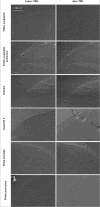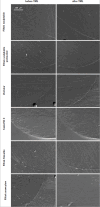Marginal Adaptation of Flowable vs Sonically Activated or Preheated Resin Composites in Cervical Lesions
- PMID: 35575657
- PMCID: PMC11734263
- DOI: 10.3290/j.jad.b3032461
Marginal Adaptation of Flowable vs Sonically Activated or Preheated Resin Composites in Cervical Lesions
Abstract
Purpose: To investigate marginal integrity of restorations applied with preheated and non-preheated composite, flowable composite, sonically activated composite, and a new thermo-viscous bulk-fill composite using near-infrared technology for preheating, in class V cavities of human molars.
Materials and methods: Standardized cavities were prepared on the buccal surfaces of 60 human mandibular molars and restored with one of the following resin composite materials after application of an etch-and-rinse adhesive (OptiBond FL, Kerr): non-preheated or preheated conventional composite (Filtek Supreme XTE, 3M Oral Care), preheated thermo-viscous composite (VisCalor bulk, Voco), soncially activated composite (SonicFill 3, Kerr), or flowable composite (Filtek Supreme XTE Flowable, 3M Oral Care) applied in bulk or as a lining material using the snow-plow technique. After light curing and polishing, the percentage of continuous margins (PCM) of the restorations in enamel and dentin was assessed using SEM both before and after thermomechanical loading (TML). TML was carried out with 3000 thermal cycles (5°C-50°C) and a simultaneous mechanical stress application with 1.2 million load-cycles (1.7 Hz, 49 N) in a computer-controlled masticator. Non-parametric statistical analysis was performed using Wilcoxon, Kruskal-Wallis, and Mann-Whitney U-tests (α = 0.05).
Results: All groups revealed a significant decline in marginal integrity after TML in both enamel and dentin. Although the flowable group in enamel and the snow-plow group in dentin showed the highest PCM before TML, the differences between the groups were compensated after TML.
Conclusion: All of the tested composites and application methods showed similar marginal integrities after thermomechanical loading and can be recommended for clinical implementation.
Keywords: flowable composite; marginal adaptation; preheating; resin composite; sonic activation.
Figures






Similar articles
-
Marginal Gap Formation in Approximal "Bulk Fill" Resin Composite Restorations After Artificial Ageing.Oper Dent. 2018 Mar/Apr;43(2):180-189. doi: 10.2341/17-068-L. Epub 2017 Nov 17. Oper Dent. 2018. PMID: 29148914
-
Marginal quality of flowable 4-mm base vs. conventionally layered resin composite.J Dent. 2011 Oct;39(10):643-7. doi: 10.1016/j.jdent.2011.07.004. Epub 2011 Jul 27. J Dent. 2011. PMID: 21801799
-
Influence of flowable liner and margin location on microleakage of conventional and packable class II resin composites.Oper Dent. 2005 Jan-Feb;30(1):32-8. Oper Dent. 2005. PMID: 15765955
-
Marginal integrity of flowable and packable bulk fill materials used for class II restorations -A systematic review and meta-analysis of in vitro studies.Dent Mater J. 2020 Jun 5;39(3):335-344. doi: 10.4012/dmj.2018-180. Epub 2020 Jan 11. Dent Mater J. 2020. PMID: 31932546
-
Effect of flowable composites on the clinical performance of non-carious cervical lesions: A systematic review and meta-analysis.J Dent. 2017 Oct;65:11-21. doi: 10.1016/j.jdent.2017.07.007. Epub 2017 Jul 17. J Dent. 2017. PMID: 28729119
Cited by
-
Improved Flexural Properties of Experimental Resin Composites Functionalized with a Customized Low-Sodium Bioactive Glass.Polymers (Basel). 2022 Oct 12;14(20):4289. doi: 10.3390/polym14204289. Polymers (Basel). 2022. PMID: 36297866 Free PMC article.
-
Marginal integrity of prototype bioactive glass-doped resin composites in class II cavities.Clin Oral Investig. 2024 Jul 16;28(8):430. doi: 10.1007/s00784-024-05824-x. Clin Oral Investig. 2024. PMID: 39012388
-
Optimizing fracture resistance of endodontically treated maxillary premolars restored with preheated thermos-viscous composite post-thermocycling, a comparative study. Part I.BMC Oral Health. 2024 Mar 2;24(1):295. doi: 10.1186/s12903-024-03959-7. BMC Oral Health. 2024. PMID: 38431585 Free PMC article.
-
Marginal Integrity of Simplified Adhesive Strategies in Primary Teeth.Int Dent J. 2023 Dec;73(6):881-888. doi: 10.1016/j.identj.2023.06.002. Epub 2023 Jun 28. Int Dent J. 2023. PMID: 37385864 Free PMC article.
-
Various ways of pre-heating a bulk-fill thermoviscous composite in restoration in non-carious cervical lesions: 12-month randomized clinical trial.Clin Oral Investig. 2023 Aug;27(8):4345-4359. doi: 10.1007/s00784-023-05054-7. Epub 2023 May 23. Clin Oral Investig. 2023. PMID: 37217713 Clinical Trial.
References
-
- Aggarwal V, Logani A, Jain V, Shah N. Effect of cyclic loading on marginal adaptation and bond strength in direct vs indirect class II MO composite restorations. Oper Dent. 2008;33:587− 592. - PubMed
-
- Atabek D, Aktaş N, Sakaryali D, Bani M. Two-year clinical performance of sonic-resin placement system in posterior restorations. Quintessence Int. 2017;48:743–751. - PubMed
-
- Ayub KV, Santos GC, Rizkalla AS, Bohay R, Pegoraro LF, Rubo JH, Santos MJ. Effect of preheating on microhardness and viscosity of 4 resin composites. J Can Dent Assoc. 2014;80:e12. - PubMed
-
- Bayne SC, Ferracane JL, Marshall GW, Marshall SJ, van Noort R. The evolution of dental materials over the past century: silver and gold to tooth color and beyond. J Dent Res. 2019;98:257–265. - PubMed
MeSH terms
Substances
LinkOut - more resources
Full Text Sources
Medical

